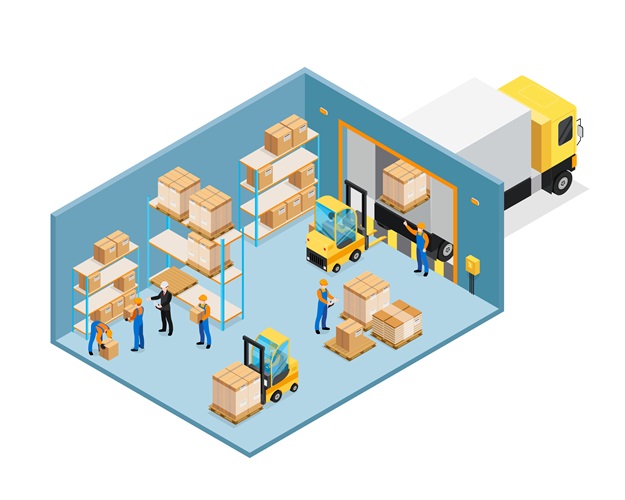Apparel and Textiles Warehouse Management System
According to a survey conducted by the International Textile Manufacturers Federation (ITMF), 45% of companies reported challenges with apparel and textile warehouse management, leading to either surplus stock or underproduction.
If you ask “what is proper warehouse management” – it is a growing need for textile manufacturers as the industry deals with a lot of raw material storage, regular shipments, order deliveries, etc. Optimizing space allocations and regular tracking of all warehouse tasks is a mandatory need. To check all these boxes off, integrating an ERP software that offers robust warehouse management is the best solution for a textile manufacturer.
In this blog, we are going to look at what a proper warehouse management system is and discuss key features an ERP warehouse management system must have.
What is Proper Warehouse Management?
There are multiple ways to manage warehouse activities in the textile industry, but the question is which is the most efficient way? The answer is simple – implement an ERP software which will allow you to leverage a warehouse management system (WMS) in the textile industry.
An ERP software will help you with effective organization, control, and monitoring of all warehouse activities, such as:
- Efficient space utilization
- Inventory management
- Detailed data analysis
- On-time order fulfilment

Key Features of Apparel and Textile Warehouse Management System
Now that we know what proper warehouse management is, let’s talk about the specific features an ERP with WMS must have.
An ERP software generally consists of a warehouse management module which is specifically designed to help textile manufacturers optimize space utilization, ensure accurate order fulfilment, and minimize storage costs. To discuss this in a more detailed manner, here are 5 key features of an ERP warehouse management system:
1. Inventory Tracking and Management
Accurate inventory tracking is the backbone of efficient apparel and textile warehouse management. An ERP software provides real-time visibility into inventory operations, such as raw material shipping, stock adjustments, cycle counting of fabrics and keeping track of batches, pallets, rolls, boxes, etc. Manufacturers also get information about precise inventory locations and movements between various warehouses.
Having up-to-date inventory information is crucial to meet customer demands and reduce holding costs.
2. Optimizing Space Utilization
Optimizing space utilization is an essential feature of an efficient warehouse management system (WMS) in textile industry. Apparel and textiles warehouse management system helps in organizing the warehouse layout, ensuring that products are stored in the most effective locations.
A WMS system can analyze data based on product dimensions, demand patterns, and picking frequencies and recommend the best storage strategies. This reduces travel time for picking and packing, minimizes congestion, and enhances overall productivity.
3. Barcode and RFID Integration
Barcode and RFID (Radio Frequency Identification) technologies are one of the main features of apparel and textiles warehouse management system. Integrating these technologies with an ERP warehouse management system enables accurate and efficient tracking of inventory and finished products.
Barcodes and RFID tags provide real-time information on product movements, reducing manual data entry and errors. This integration enhances inventory accuracy, speeds up the receiving and shipping processes, and improves overall warehouse efficiency.
4. Integration with Other ERP Modules
One of the main advantages of an ERP warehouse management module is its ability to easily integrate with multiple modules within the software. Apparel and textiles warehouse management is closely linked with other processes such as procurement, production, and sales. An ERP software ensures that these functions communicate effectively, providing a streamlined flow of operations.
For example, when a sales order is placed, the inventory management module checks inventory levels to ensure the required products are available. If inventory is insufficient, the system can automatically trigger the purchase management module to initiate purchasing or the PPC module to update production schedules. The warehouse management module then manages the physical handling, picking, and shipping of goods. This integration streamlines operations, reduces delays, and enhances customer satisfaction.
5. Real-Time Data and Analytics
Having access to real-time data is a necessity for textile manufacturers to make informed decisions. Apparel and textiles warehouse management system provides real-time analytics and reporting capabilities, enabling textile businesses to monitor key performance indicators (KPIs) and identify trends.
This data-driven approach allows textile companies to respond quickly to market changes, optimize inventory levels, and improve overall efficiency. Real-time insights also help in identifying bottlenecks and areas for improvement, leading to continuous process optimization.
Implementing an apparel and textiles warehouse management system is essential for success in the competitive industry. It ensures efficient space utilization, accurate inventory tracking, and seamless integration with other business processes.
Warehouse management system (WMS) in textile industry minimizes errors, reduces costs, and improves customer satisfaction, ensuring timely and accurate order deliveries. Adopting a specialized software tailored for the textile industry can empower businesses to streamline operations, reduce waste, and achieve long-term sustainability in a fast-paced market.

